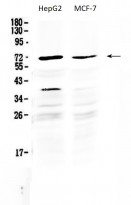ARG59008
anti-MAK antibody
anti-MAK antibody for Western blot and Human
Overview
| Product Description | Rabbit Polyclonal antibody recognizes MAK |
|---|---|
| Tested Reactivity | Hu |
| Tested Application | WB |
| Host | Rabbit |
| Clonality | Polyclonal |
| Isotype | IgG |
| Target Name | MAK |
| Antigen Species | Human |
| Immunogen | Synthetic peptide corresponding to aa. 588-623 of Human MAK (RTYNPTAKNLNIVNRAQPIPSVHGRTDWVAKYGGHR). |
| Conjugation | Un-conjugated |
| Alternate Names | RP62; Male germ cell-associated kinase; dJ417M14.2; Serine/threonine-protein kinase MAK; EC 2.7.11.22 |
Application Instructions
| Application Suggestion |
|
||||
|---|---|---|---|---|---|
| Application Note | * The dilutions indicate recommended starting dilutions and the optimal dilutions or concentrations should be determined by the scientist. |
Properties
| Form | Liquid |
|---|---|
| Purification | Affinity purification with immunogen. |
| Buffer | 0.2% Na2HPO4, 0.9% NaCl, 0.05% Sodium azide and 5% BSA. |
| Preservative | 0.05% Sodium azide |
| Stabilizer | 5% BSA |
| Concentration | 0.5 mg/ml |
| Storage Instruction | For continuous use, store undiluted antibody at 2-8°C for up to a week. For long-term storage, aliquot and store at -20°C or below. Storage in frost free freezers is not recommended. Avoid repeated freeze/thaw cycles. Suggest spin the vial prior to opening. The antibody solution should be gently mixed before use. |
| Note | For laboratory research only, not for drug, diagnostic or other use. |
Bioinformation
| Database Links |
Swiss-port # P20794 Human Serine/threonine-protein kinase MAK |
|---|---|
| Gene Symbol | MAK |
| Gene Full Name | male germ cell-associated kinase |
| Background | The product of this gene is a serine/threonine protein kinase related to kinases involved in cell cycle regulation. It is expressed almost exclusively in the testis, primarily in germ cells. Studies of the mouse and rat homologs have localized the kinase to the chromosomes during meiosis in spermatogenesis, specifically to the synaptonemal complex that exists while homologous chromosomes are paired. There is, however, a study of the mouse homolog that has identified high levels of expression in developing sensory epithelia so its function may be more generalized. Three transcript variants encoding different isoforms have been found for this gene. [provided by RefSeq, Jul 2011] |
| Function | Essential for the regulation of ciliary length and required for the long-term survival of photoreceptors (By similarity). Phosphorylates FZR1 in a cell cycle-dependent manner. Plays a role in the transcriptional coactivation of AR. Could play an important function in spermatogenesis. May play a role in chromosomal stability in prostate cancer cells. [UniProt] |
| Cellular Localization | Nucleus. Cytoplasm, cytoskeleton, microtubule organizing center, centrosome. Cytoplasm, cytoskeleton, spindle. Midbody. Cell projection, cilium, photoreceptor outer segment. Photoreceptor inner segment. Localized in both the connecting cilia and the outer segment axonemes (By similarity). Localized uniformly in nuclei during interphase, to the mitotic spindle and centrosomes during metaphase and anaphase, and also to midbody at anaphase until telophase. [UniProt] |
| Calculated MW | 71 kDa |
| PTM | Autophosphorylated. Phosphorylated on serine and threonine residues. [UniProt] |
Images (1) Click the Picture to Zoom In






